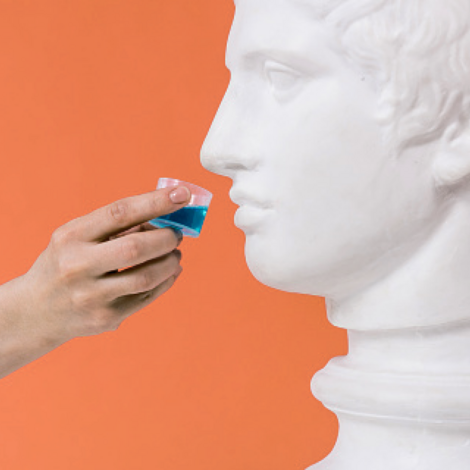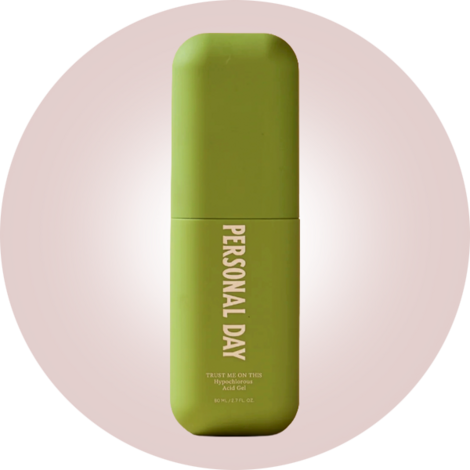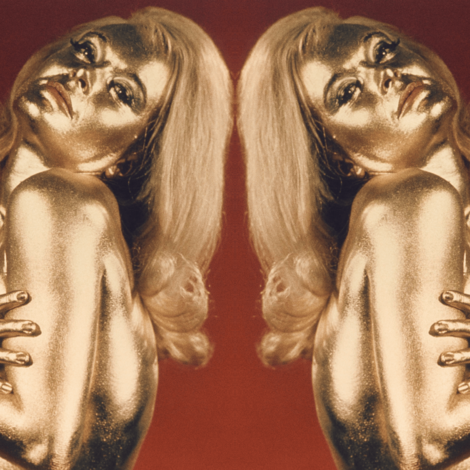First came the nail bar; next it was the brow bar to better bushify yours into the perfect pair of face-framers. Now brace yourselves for the next appointment in your ever-expanding calendar of self-care: the chin bar. This new import from Paris (where French women wear their tweakments lightly and subtly) promises to tighten, sharpen, and—TikTok vocab incoming — “snatch” social media and the beauty industry’s latest focal point to aesthetic perfection.
At FaceStellar, the Voyager spaceship-themed “gender fluid beauty space” in South Kensington, London, a row of silver chairs awaits the chin-trepid. For $110, its 55-minute non-invasive Sharpen facial offers a “sculpted jawline, lifted face oval and jowls, defined cheekbones, and slim, snatched face.” For those wondering, this is Gen Z for a jawline that looks—tellingly—as though you might have had a face-lift to staple it in place. It and the jawline in question have been appropriated from the stage-performer technique of securing one’s face with tape to achieve a more contoured profile.
FaceStellar promises to approximate the same look through a process of manual sculpting, electronic muscle stimulation, and scraping with a steel gua sha, a facial tool shaped like a plectrum that has been co-opted from traditional Chinese medicine. With optional add-ons such as peels, UV light, and “collagen broth,” the salon is a walk-in service for faces in much the same way that a nail bar offers everything from cuticle management to stick-on gems. The company already has two outposts in Paris, in the ritzy 1st arrondissement and the hipster 9th.
Theirs is a booming sector. After the contouring makeup craze of the previous decade, which involved blending various shades of foundation to create the appearance of shadow and light (again, in the way drag artists have long done for the stage) and was more convincing on camera than in real life, here is a version that doesn’t wash off. Last year, removal of buccal fat—the reserves between the cheekbones and the jawbone—became the latest craze to create the desired hollow-cheeked look, à la Anya Taylor-Joy and Jenna Ortega. In the U.S., chin augmentation procedures rose by 29 percent between 2020 and 2021, while face liposuction—including chin lipo—rose by 99 percent.
I Feel Bad About My Neck was the title of Nora Ephron’s 2006 book of essays on womanhood, and she didn’t even have camera phones or high definition to contend with. Selfies have made firm jawlines and the perfect pointed chin the latest impossible standard. As we’ve learned to hold our phones tilted on high to better skew our features into those of bug-eyed, tapering-jawed cartoon aliens, so we have forgotten—until we catch sight of ourselves in mirrors or (horror) other people’s photos—that the reality of our features is rather different. Sitting on Zoom all day opened up our jowls to new scrutiny—not from other attendees, but from ourselves—and the industry has been lying in wait.
Radio-frequency to stimulate collagen and elastin around the jawline; fat-reducing enzyme injections to break down the pad of fat underneath. CoolSculpting, the fat-freezing treatment that the supermodel Linda Evangelista claimed left her “disfigured” in a rare side-effect, is another popular non-surgical treatment for this area. Airsculpt is a new procedure from the Beverly Hills-based Dr. Aaron Rollins. It removes fat through a freckle-sized hole, costs about $10,000, and just launched in London. Chins are his favorite spot for seeing the most difference.
“Selfies and tech neck have made us all slightly paranoid about our jawlines,” says the beauty editor and influencer Nadine Baggott. “Radio-frequency and micro-needling are massive, but manage your expectations about how much they will lift—it’s more about improving the texture of the skin.”
Back to the chin bar’s massage-based approach—does it actually work? After an hour’s worth of pinching, pummeling, and focused upward-flicking from my therapist, there is more of a dip beneath my cheekbones than usual and I look less puffy from a toddler-related broken night’s sleep. My chin, underneath which there has been since childhood a soft little strap that bothers me only if I let it, looks exactly the same.
So far, so much lymphatic drainage. Hollywood types have relied on facial massage such as this for a temporary glow before red-carpet events and public appearances for decades. The British company FaceGym has offered something similar since 2014. Its in-house pummelers stop halfway through to show you a wonky reflection with one side of your face manually de-puffed in contrast to the other. Perhaps a better question is, how long until it drops again?
“A good facial can sculpt, contour, and redefine the face in a lovely way,” says the cosmetic surgery expert Alice Hart-Davis, whose Web site thetweakmentsguide.com is an encyclopedia of anti-aging hacks. “But it’s not going to last. [Double chins] are genetic—better to choose your parents with care.”
“I don’t think it can lift a face,” Baggott says. “If you’re that person who has a salty meal or a drink and carries fluid, massage will draw out the fluid. But you can guarantee anybody with a firm jawline over the age of 50 has had surgery.”
What of the myriad neck creams, wraps, and tonics—such as Dr. Barbara Sturm’s $225 cult favorite and La Mer’s $330 The Neck & Décolleté Concentrate, which comes with an application brush—that are proliferating in direct correlation to the angst generated online about this area?
“If a neck cream could defy gravity, we’d have no need for rocket boosters on spaceships,” Baggott replies definitively. “Take all of your skin care down to your nipples because your neck and chest show the first signs of aging. But short of a face-lift, nothing is going to stop the drop.”
Or thin the chin, for that matter. Book a session at FaceStellar for a glow-boost or to mitigate the worse effects of a hangover, but whatever you walked in with is likely to come home with you, too. Keep your chin up, though: the best advice I have had from a photographer is to jut your jaw forward in pictures to create a firmer line. You’re welcome—now get on with the rest of your life.
Harriet Walker is the fashion editor of The Times of London





